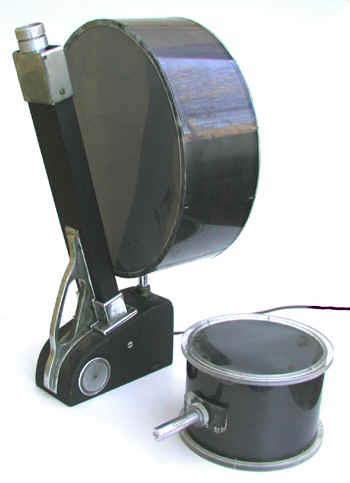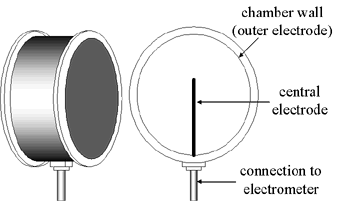Condenser Ionization Chamber for Measuring X-ray Emissions from Television Sets

The two condenser ion chambers shown here were constructed for Carl Braestrup and Richard Mooney at New York’s Francis Delafield Hospital. They were designed to measure the low-level X-ray emissions from the picture tubes of television sets. Condenser chambers provided the required sensitivity because the ionization could be integrated over an extended period of time. The first version of the chamber, built in 1947, employed three flat parallel electrodes with the central electrode fabricated from nylon gauze made conductive with a coating of aquadag. The later version, shown here, employed an aluminum rod as the central electrode. This increased the sensitivity by reducing the system’s capacitance, although it also resulted in a non-uniform electric field. The plastic chamber wall is coated on the inside with aquadag to make it conductive. The larger of the two chambers is 12" in diameter and 4" thick while the smaller unit is 6" in diameter and 4" thick. The windows are made of thin (Ł 0.5 mm) polystyrene.

At the time of the study, the International Commission on Radiological Protection (ICRP) recommended that the exposure rate on any accessible surface of a television set be limited to 2.1 mR/hr. As a result of their measurements, Braestrup and Mooney concluded (1959) that “a permissible radiation level of 0.5 mr per hour 5 cm from any accessible surface of the equipment [a value under consideration] appears reasonable and will not require any changes in most existing sets.” This recommendation was later adopted by the NCRP and ICRP and it became the regulatory limit currently specified in 21 CFR 1020.10 by the FDA.
It was a lawsuit that first alerted the authorities to the potential emission of X-rays from television sets (CRTs).
After assembling a television set that came in the form of a kit, a gentleman suffered skin damage to his hands and face. When his doctor indicated that the damage appeared to be a radiation burn, the matter was taken to court. Unfortunately for the plaintiff, Braestrup testified that the X-ray output from the television had been too low to produce the observed skin damage. The latter turned out to be an allergic reaction to the soldering flux used in assembling the kit (Carl Braestrup. BRH Vignettes of Early Radiation Workers).
Carl B. Braestrup (1897-1982) was born in Copenhagen Denmark. He worked as an engineer at Bell Telephone Laboratories and Picker X-ray Corporation, instructed at the Post Graduate Medical School of Columbia University, and served as the Director of the Physics Laboratory of the New York City Department of Hospitals. He was one of the first in the 1930’s to develop a film badge that would account for the energy of the radiation and was one of the first ten persons certified in X-ray physics by the Radiological Society of North America. An internationally recognized expert on shielding design, he developed a standardized approach to the shielding design for medical and industrial X-ray facilities that formed the basis of the NCRP 49 methodology. Together with Harold Wyckoff, he coauthored the classic textbook Radiation Protection (1958).
Instruments donated by Richard Mooney.
Reference
Braestrup, C. B., and Mooney, R. T. X-ray Emission from Television Sets, Science 130: 1071-1074, Oct. 23, 1959.
